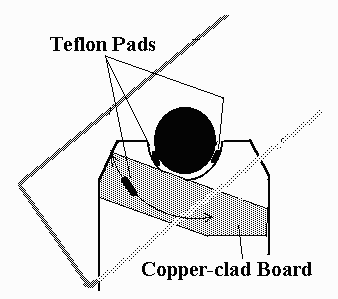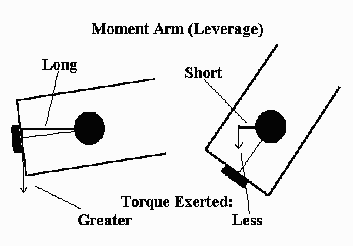Balancing a Dobsonian
Jack Kramer
In separate article, I wrote about correcting the problem of the club's telescope not holding its position in altitude. The resolution boils down to the fine art of adjusting the equilibrium point of the tube and providing just the right amount of friction in the mounting. If you have a Dobsonian-mounted scope of your own, then you're familiar with the situation. Several years ago, we added a new focusing mount and a finder. This necessitated moving the primary mirror closer to the secondary and shortening the tube by a couple of inches. Since the scope was now out of balance, we moved the altitude bearings. Then a couple of years ago, the finder was replaced with a Telrad, and that slightly changed the balance again. Rather than try some more counterbalancing, I opted to tinker with the mounting. On each side of the tube there are teflon pads that bear against the inner sides of the rocker box when the scope is aimed from about 30o from the horizontal on up to the zenith. Through friction against the wooden box, these pads provide some braking action. However, as the scope swung higher overhead, the pads now bore against the sides with decreasing pressure, allowing the telescope tube to move too freely. This was caused due to the rocker box not being perfectly square; perhaps the sides have warped outward slightly. The solution was to add a piece of 1/16" thick copper clad circuit board material on one of the inside surfaces of the rocker box where a teflon pad bears against it. This keeps the scope from slipping and seems to have smoothed out the altitude motion somewhat. This material came from my junk drawer (origin unknown), but you probably could find similar stuff at places like the American Science Center or Harrison Supply in Wheeling.

In a situation where a Dobsonian telescope is slightly out of balance, a common solution is to add counterweights along the tube or on one end to achieve the desired equilibrium. Some observers even achieve a temporary fix by taping a crescent wrench or other heavy object to the tube in order to balance it while using a large eyepiece! But any permanent addition of weights is fraught with other problems, not the least of which is that the telescope now becomes that much heavier and less manageable. And as the telescope swings about the altitude axis, the point of equilibrium is constantly changing. Adding weights along the tube works well for the short tubed Schmidt-Cassegrains, but on longer tubed Dobsonians, the counterbalancing effect of the weight changes slightly as the effective moment arm shifts with tube rotation. This can result in the telescope tube having an annoying mind of its own when you try to make subtle movements to follow an object in the eyepiece. The following is an over-simplified illustration of what happens with a weight mounted at the base of the telescope tube. Of course, the force exerted by the weight of the upper part of the tube is also affected by movement around the altitude axis.

Some telescope builders make the weights easily moveable, which also helps as accessories are added. On a German equatorial mount, this can be accomplished by repositioning the counterweight on the declination axle and/or for-and-aft movement of the tube in its saddle. If the out-of-balance condition isn't severe, a good solution is to provide some braking action by adding friction or an adjustable clutch on the axes of the mounting. With the club scope, we added friction by "tightening" the rocker box 1/16 of an inch (the thickness of the circuit board). A similar problem occurs with equatorial mounts that are too flimsy to hold the telescope in place as it's aimed toward different areas of the sky. An axle riding in a sleeve generally has more friction in direct proportion to the surface area in contact. In fact, many of us set out to build a smoothly-operating telescope, only to be surprised to find that it moves too easily. Some friction has to be added to ensure that it stays where it's aimed without constantly putting on and taking off counterweights.
Another catch-22 can occur when using a lightweight, thin mirror in a Dobsonian-mounted telescope. To use the more efficient low-to-the-ground rocker box, you have to add a substantial counterweight at the primary mirror end in order to balance the telescope. But then you've just defeated one of the two advantages of the lightweight mirror! (The other advantage is lower cost.)
Published in the May 1994 issue of the NightTimes




